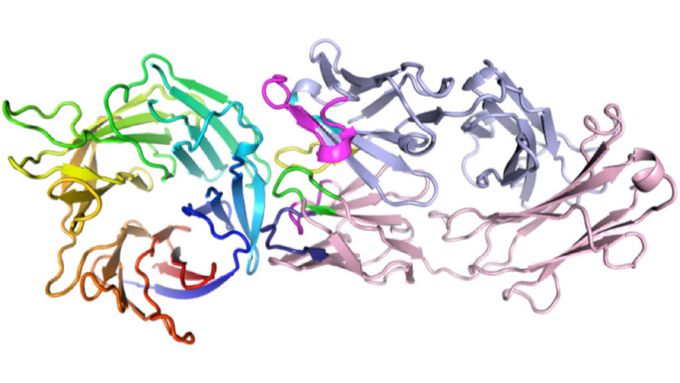The Achilles Heel of Plasmodia - Advances in Vaccine Development against Malaria
03.03.2017 by Melanie Rast
The protein CyRPA could be an important component for an efficient vaccine against Plasmodium falciparum, the most deadly of all malarial pathogens. Scientists from the Swiss Tropical and Public Health Institute have identified CyRPA and demonstrated that specific antibodies to this protein prevent plasmodia from penetrating and proliferating within red blood cells. In collaboration with Roche, the Swiss TPH researchers elucidated the structure of the protein region to which the protective antibodies bind. With this knowledge, the specific protein region can be replicated exactly and used as a vaccine component.

Structure of the interface between CyRPA and antibody.
To date, there is no highly effective vaccination against malaria available. In collaboration with Joerg Benz and Markus Rudolph from the Roche Structural Biologie Unit, the Swiss TPH research group headed by Gerd Pluschke is now one step closer to this goal: If antibodies bind to a specific region of the protein CyRPA, it prevents the penetration of plasmodia into the red blood cells. In their recent work, the researchers analysed the structure of the binding site of protective antibodies to CyRPA. "The knowledge of the exact structure is necessary to replicate antigens reflecting the critical regions of the protein," explains Paola Favuzza, one of the scientists involved. After vaccination with these precise "replicas", the immune system can develop an efficient protection against the parasites.
Search for Hidden Antigens
The variability of antigens is a major problem in the development of vaccines against malaria. Most plasmodial surface proteins differ greatly among the various Plasmodia strains. For this reason, they are not a suitable starting point for a vaccine. "We must recognise the parasite's Achilles heel and present it to the immune system in such a way that a strong immune response is triggered," says Pluschke. The researchers of Swiss TPH therefore, specifically looked for proteins that are necessary for the penetration of plasmodia into the red blood cells, but only appear briefly at the cell surface. These antigens produce little natural immune response and are, for the most part, not very variable. Thus, antibodies against them can provide protection against the whole parasite population.
Combination of Antigens for an Efficient Malarial Vaccine
With the characterisation of the binding site of protective antibodies to CyRPA, copies of the critical regions of CyRPA can now be produced and incorporated into a vaccine as an additional component. In this vaccine, the malarial antigens would be located on the surface of virus-like particles (virosomes). In a clinical trial of a prototype with two malaria components, a strong immune response and first efficacy was observed with no undesirable side effects. "We hope that with a vaccine that contains three other parasite antigens in addition to CyRPA, we can achieve effective protection against malaria," says Pluschke. "Systematic selection of antigens using genome analysis, exact structure analysis and innovative methods for the design of synthetic protein domains bring us closer to the goal of developing an efficient malaria vaccination".
Contact

Gerd Pluschke
Professor, PhD
Scientific Group Leader
+41612848235
gerd.pluschke@swisstph.ch
Stay connected
Subscribe to our newsletter and get all the latest research news, project updates, course and event listings from Swiss TPH.